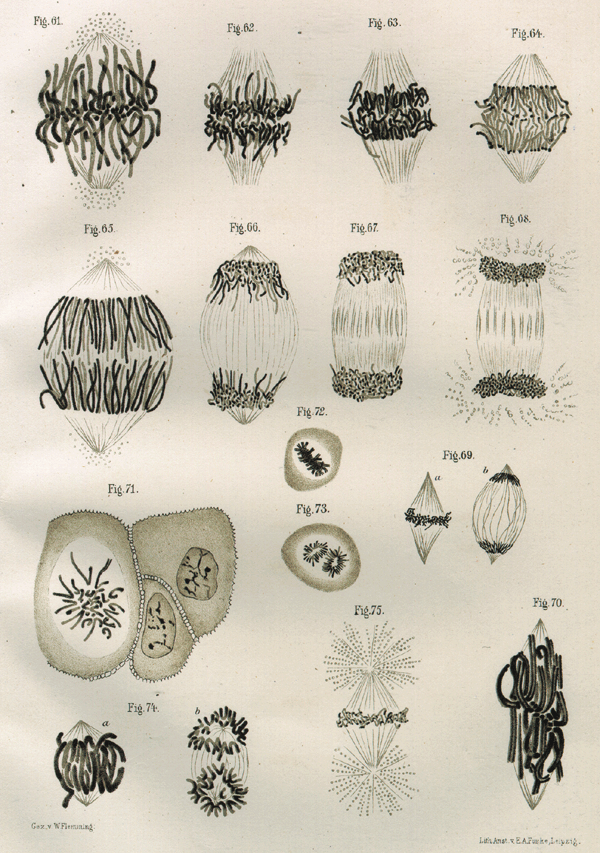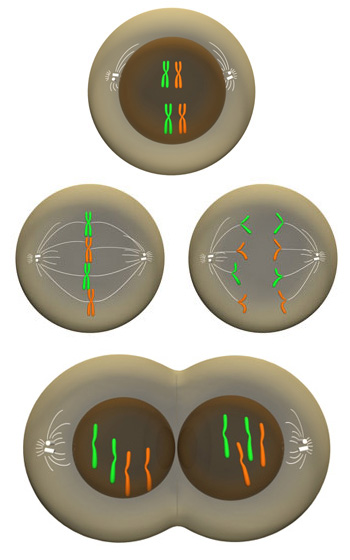What Would Have to Happen to the Chromosomes in Interphase in Order for the Cells to Divide Again
Mitosis is the process in which a eukaryotic prison cell nucleus splits in 2, followed past partitioning of the parent cell into two daughter cells. The word "mitosis" means "threads," and it refers to the threadlike appearance of chromosomes every bit the cell prepares to split up. Early microscopists were the kickoff to observe these structures, and they also noted the advent of a specialized network of microtubules during mitosis. These tubules, collectively known as the spindle, extend from structures called centrosomes — with 1 centrosome located at each of the opposite ends, or poles, of a prison cell. As mitosis progresses, the microtubules adhere to the chromosomes, which have already duplicated their DNA and aligned across the center of the cell. The spindle tubules so shorten and move toward the poles of the prison cell. Equally they move, they pull the one copy of each chromosome with them to opposite poles of the cell. This process ensures that each girl cell will contain one verbal copy of the parent cell Deoxyribonucleic acid.
What Are the Phases of Mitosis?
Mitosis consists of five morphologically singled-out phases: prophase, prometaphase, metaphase, anaphase, and telophase. Each phase involves feature steps in the procedure of chromosome alignment and separation. One time mitosis is complete, the entire cell divides in two by manner of the process called cytokinesis (Figure 1).

Effigy 1: Drawing of chromosomes during mitosis by Walther Flemming, circa 1880
This analogy is ane of more than one hundred drawings from Flemming's \"Cell Substance, Nucleus, and Cell Division.\" Flemming repeatedly observed the different forms of chromosomes leading up to and during cytokinesis, the ultimate division of one cell into two during the last stage of mitosis.
© 2001 Nature Publishing Group Paweletz, Northward. Walther Flemming: pioneer of mitosis enquiry. Nature Reviews Molecular Cell Biology 2, 72 (2001). All rights reserved. ![]()
What Happens during Prophase?
Prophase is the first stage in mitosis, occurring after the decision of the Gii portion of interphase. During prophase, the parent prison cell chromosomes — which were duplicated during S phase — condense and become thousands of times more than meaty than they were during interphase. Considering each duplicated chromosome consists of ii identical sister chromatids joined at a point called the centromere, these structures at present appear as X-shaped bodies when viewed under a microscope. Several DNA binding proteins catalyze the condensation process, including cohesin and condensin. Cohesin forms rings that agree the sis chromatids together, whereas condensin forms rings that ringlet the chromosomes into highly meaty forms.
The mitotic spindle as well begins to develop during prophase. Equally the cell's two centrosomes move toward opposite poles, microtubules gradually assemble between them, forming the network that will later on pull the duplicated chromosomes apart.
What Happens during Prometaphase?
When prophase is consummate, the prison cell enters prometaphase — the 2d stage of mitosis. During prometaphase, phosphorylation of nuclear lamins by M-CDK causes the nuclear membrane to break down into numerous small vesicles. Equally a effect, the spindle microtubules at present have directly admission to the genetic material of the cell.
Each microtubule is highly dynamic, growing outward from the centrosome and collapsing backward as it tries to locate a chromosome. Eventually, the microtubules find their targets and connect to each chromosome at its kinetochore, a complex of proteins positioned at the centromere. The actual number of microtubules that attach to a kinetochore varies between species, merely at to the lowest degree one microtubule from each pole attaches to the kinetochore of each chromosome. A tug-of-state of war and so ensues equally the chromosomes motion back and forth toward the two poles.
What Happens during Metaphase and Anaphase?
Every bit prometaphase ends and metaphase begins, the chromosomes align along the cell equator. Every chromosome has at least two microtubules extending from its kinetochore — with at to the lowest degree one microtubule connected to each pole. At this signal, the tension within the cell becomes balanced, and the chromosomes no longer motion dorsum and forth. In addition, the spindle is now complete, and three groups of spindle microtubules are apparent. Kinetochore microtubules attach the chromosomes to the spindle pole; interpolar microtubules extend from the spindle pole across the equator, about to the opposite spindle pole; and astral microtubules extend from the spindle pole to the cell membrane.
Metaphase leads to anaphase, during which each chromosome's sister chromatids carve up and move to opposite poles of the cell. Enzymatic breakup of cohesin — which linked the sister chromatids together during prophase — causes this separation to occur. Upon separation, every chromatid becomes an independent chromosome. Meanwhile, changes in microtubule length provide the mechanism for chromosome movement. More specifically, in the first part of anaphase — sometimes chosen anaphase A — the kinetochore microtubules shorten and draw the chromosomes toward the spindle poles. Then, in the 2nd office of anaphase — sometimes chosen anaphase B — the astral microtubules that are anchored to the cell membrane pull the poles farther apart and the interpolar microtubules slide past each other, exerting additional pull on the chromosomes (Figure two).

Figure two: Types of microtubules involved in mitosis
During mitosis, several types of microtubules are active. The motor proteins associated with the interpolar microtubules drive the assembly of the spindle. Note the other types of microtubules involved in anchoring the spindle pole and pulling autonomously the sis chromatids.
What Happens during Telophase?
During telophase, the chromosomes go far at the cell poles, the mitotic spindle disassembles, and the vesicles that contain fragments of the original nuclear membrane gather around the 2 sets of chromosomes. Phosphatases then dephosphorylate the lamins at each end of the cell. This dephosphorylation results in the formation of a new nuclear membrane around each grouping of chromosomes.
When Do Cells Actually Divide?
Cytokinesis is the physical process that finally splits the parent cell into two identical daughter cells. During cytokinesis, the cell membrane pinches in at the prison cell equator, forming a cleft called the cleavage furrow. The position of the furrow depends on the position of the astral and interpolar microtubules during anaphase.
The cleavage furrow forms because of the action of a contractile ring of overlapping actin and myosin filaments. As the actin and myosin filaments movement past each other, the contractile ring becomes smaller, akin to pulling a drawstring at the superlative of a purse. When the ring reaches its smallest point, the cleavage furrow completely bisects the prison cell at its center, resulting in two separate daughter cells of equal size (Figure 3).

Effigy 3: Mitosis: Overview of major phases
The major stages of mitosis are prophase (elevation row), metaphase and anaphase (center row), and telophase (bottom row).
Conclusion
Mitosis is the process of nuclear division, which occurs just prior to prison cell division, or cytokinesis. During this multistep process, cell chromosomes condense and the spindle assembles. The duplicated chromosomes and then attach to the spindle, align at the cell equator, and move apart as the spindle microtubules retreat toward opposite poles of the cell. Each set of chromosomes is then surrounded by a nuclear membrane, and the parent cell splits into two consummate girl cells.
Source: https://www.nature.com/scitable/topicpage/mitosis-14046258/
0 Response to "What Would Have to Happen to the Chromosomes in Interphase in Order for the Cells to Divide Again"
Post a Comment